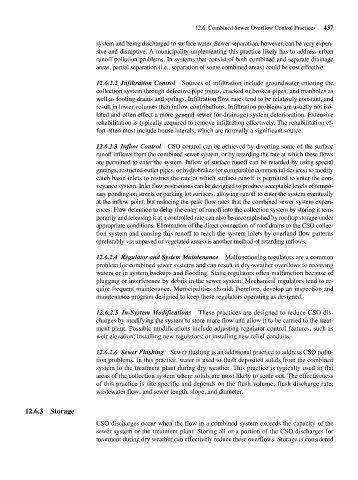Page 479 - Fair, Geyer, and Okun's Water and wastewater engineering : water supply and wastewater removal
P. 479
JWCL344_ch12_398-456.qxd 8/4/10 9:37 PM Page 437
12.6 Combined Sewer Overflow Control Practices 437
system and being discharged to surface water. Sewer separation, however, can be very expen-
sive and disruptive. A municipality implementing this practice likely has to address urban
runoff pollution problems. In systems that consist of both combined and separate drainage
areas, partial separation (i.e., separation of some combined areas) could be cost effective.
12.6.2.2 Infiltration Control Sources of infiltration include groundwater entering the
collection system through defective pipe joints, cracked or broken pipes, and manholes as
well as footing drains and springs. Infiltration flow rates tend to be relatively constant, and
result in lower volumes than inflow contributions. Infiltration problems are usually not iso-
lated and often effect a more general sewer (or drainage) system deterioration. Extensive
rehabilitation is typically required to remove infiltration effectively. The rehabilitation ef-
fort often must include house laterals, which are normally a significant source.
12.6.2.3 Inflow Control CSO control can be achieved by diverting some of the surface
runoff inflows from the combined sewer system, or by retarding the rate at which these flows
are permitted to enter the system. Inflow of surface runoff can be retarded by using special
gratings, restricted outlet pipes, or hydrobrakes (or comparable commercial devices) to modify
catch basin inlets to restrict the rate at which surface runoff is permitted to enter the con-
veyance system. Inlet flow restrictions can be designed to produce acceptable levels of tempo-
rary ponding on streets or parking lot surfaces, allowing runoff to enter the system eventually
at the inflow point, but reducing the peak flow rates that the combined sewer system experi-
ences. Flow detention to delay the entry of runoff into the collection system by storing it tem-
porarily and releasing it at a controlled rate can also be accomplished by rooftop storage under
appropriate conditions. Elimination of the direct connection of roof drains to the CSO collec-
tion system and causing this runoff to reach the system inlets by overland flow patterns
(preferably via unpaved or vegetated areas) is another method of retarding inflows.
12.6.2.4 Regulator and System Maintenance Malfunctioning regulators are a common
problem for combined sewer systems and can result in dry-weather overflows to receiving
waters or in system backups and flooding. Static regulators often malfunction because of
plugging or interference by debris in the sewer system. Mechanical regulators tend to re-
quire frequent maintenance. Municipalities should, therefore, develop an inspection and
maintenance program designed to keep these regulators operating as designed.
12.6.2.5 In-System Modifications These practices are designed to reduce CSO dis-
charges by modifying the system to store more flow and allow it to be carried to the treat-
ment plant. Possible modifications include adjusting regulator control features, such as
weir elevation; installing new regulators; or installing new relief conduits.
12.6.2.6 Sewer Flushing Sewer flushing is an additional practice to address CSO pollu-
tion problems. In this practice, water is used to flush deposited solids from the combined
system to the treatment plant during dry weather. This practice is typically used in flat
areas of the collection system where solids are most likely to settle out. The effectiveness
of this practice is site specific and depends on the flush volume; flush discharge rate;
wastewater flow; and sewer length, slope, and diameter.
12.6.3 Storage
CSO discharges occur when the flow in a combined system exceeds the capacity of the
sewer system or the treatment plant. Storing all or a portion of the CSO discharges for
treatment during dry weather can effectively reduce these overflows. Storage is considered

